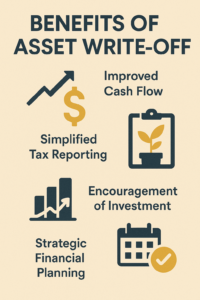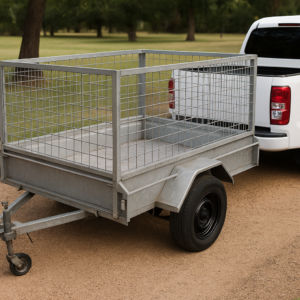For many small business owners in Australia, managing finances strategically is essential to long-term success. One often underutilised yet highly beneficial mechanism available through the Australian taxation system is the Asset Write-Off—formally referred to as the Instant Asset Write-Off (IAWO).
We explore the fundamentals of the Asset Write-Off, who it applies to, how it works, its limits and exclusions, and why it remains a key financial strategy for small business owners across the country.
Understanding the Instant Asset Write-Off for Australian Small Businesses
What Is an Asset Write-Off?
The Asset Write-Off allows eligible small businesses to claim an immediate tax deduction for the full purchase price of an eligible business asset, rather than depreciating the asset over several years.
This can be a significant cash flow advantage, especially in capital-intensive industries such as construction, transport, and hospitality.
Introduced as part of Australia’s broader small business tax reform, the write-off was designed to stimulate investment by reducing the upfront cost burden of acquiring necessary equipment or tools.
Who Can Access the Asset Write-Off?
Eligibility for the Asset Write-Off is determined by several criteria. As of the current legislation covering the period 1 July 2023 to 30 June 2025, a business must:
- Have an aggregated annual turnover of less than $10 million;
- Be using the simplified depreciation rules provided by the Australian Taxation Office (ATO);
- Have purchased and used (or be ready to use) the asset within the financial year the deduction is claimed.
The turnover test is calculated on an aggregated basis, meaning the combined annual turnover of your business and any associated entities.
This ensures that businesses operating under multiple structures still fall within the eligibility criteria (ATO, 2024)¹.

Current Threshold for Asset Write-Off
As of the current tax period, the threshold for an individual asset write-off is $20,000 (excluding GST if registered).
This means that eligible businesses can purchase multiple qualifying assets throughout the year and claim each one as long as their individual cost does not exceed the $20,000 threshold.
This threshold applies to both new and second-hand assets, providing flexibility for businesses seeking affordable options.
The government has announced an extension of this scheme to 30 June 2025, following bipartisan support for small business recovery initiatives (Treasury, 2024)².
Example in Practice
To illustrate: A sole trader operating a landscaping business purchases a second-hand trailer for $17,500 in October 2024.
Provided the asset is used or ready for use within that financial year, and the business meets all other eligibility requirements, the full cost of the trailer can be written off in the 2024–25 tax return.
This results in immediate tax relief and improves end-of-year cash flow.

Limitations and Exclusions
While the Asset Write-Off is a powerful tool, it does not apply to all purchases or circumstances.
The following conditions and exclusions are important to note:
1. Asset Cost Exceeds Threshold
If the asset costs more than $20,000, it must be depreciated over time under the general small business pool at 15% in the first year and 30% thereafter (ATO, 2024)³.
2. Business-Use Proportion
You may only claim the portion of the asset used for business purposes.
For example, if you purchase a $2,500 laptop but only use it 70% of the time for business activities, you can claim $1,750 as a deduction.
3. Excluded Asset Categories
Some assets are ineligible for the write-off, including:
- Capital works (e.g., buildings and structural improvements)
- Intangible assets such as in-house developed software
- Leased assets under certain conditions
A full list of exclusions is available on the ATO’s official Instant Asset Write-Off page.
Record Keeping and Compliance
To claim an Asset Write-Off, businesses must maintain proper documentation, including:
- Purchase invoices
- Asset usage logs (for mixed-use assets)
- Installation or use dates
- Evidence of business purpose
Failing to provide adequate records may result in deductions being disallowed during an audit.
Benefits of the Asset Write-Off
The primary benefits of the Asset Write-Off for small businesses include:
- Improved cash flow through accelerated deductions
- Simplified tax reporting via upfront deduction rather than long-term depreciation
- Encouragement of capital investment, which can enhance productivity and growth
- Strategic financial planning opportunities near the end of the financial year
The scheme supports long-term planning, especially for businesses in need of frequent asset upgrades, such as tech-based service providers or trades reliant on vehicles and tools.
Final Thoughts
The Asset Write-Off remains one of the most practical and accessible tax tools available to small businesses in Australia.
While tax legislation can often be complex, this scheme provides a clear, immediate incentive for small businesses to invest in their operations while reducing their taxable income.
Nonetheless, as tax legislation is subject to frequent updates, and asset eligibility can vary, it is essential to consult a qualified accountant or tax adviser before making any large purchases intended for write-off purposes.

Disclaimer For External Distribution Purposes
The information contained in this publication is for general information purposes only, professional advice should be obtained before acting on any information contained herein. The receiver of this document accepts that this publication may only be distributed for the purposes previously stipulated and agreed upon at subscription. Neither the publishers nor the distributors can accept any responsibility for loss occasioned to any person as a result of action taken or refrained from in consequence of the contents of this publication.
References
- Australian Taxation Office (ATO). “Instant Asset Write-Off.” Accessed April 2025. https://www.ato.gov.au/business/depreciation-and-capital-expenses-and-allowances/instant-asset-write-off/
- Australian Treasury. “Budget Measures: Supporting Small Businesses.” Published October 2023. https://budget.gov.au
- ATO. “Simpler Depreciation for Small Business.” Accessed April 2025. https://www.ato.gov.au/business/depreciation-and-capital-expenses-and-allowances/simpler-depreciation-for-small-business/
Contents
- 1 Understanding the Instant Asset Write-Off for Australian Small Businesses
- 2 What Is an Asset Write-Off?
- 3 Who Can Access the Asset Write-Off?
- 4 Current Threshold for Asset Write-Off
- 5 Example in Practice
- 6 Limitations and Exclusions
- 7 Record Keeping and Compliance
- 8 Benefits of the Asset Write-Off
- 9 Final Thoughts

